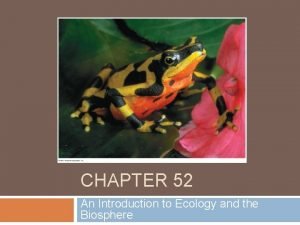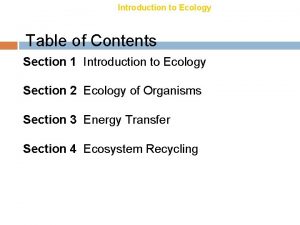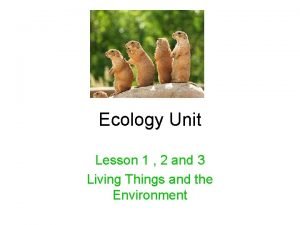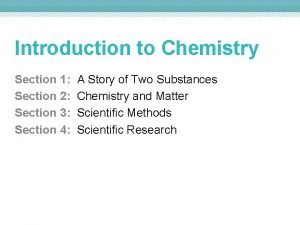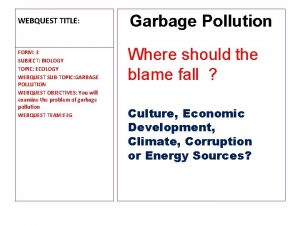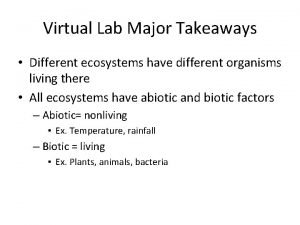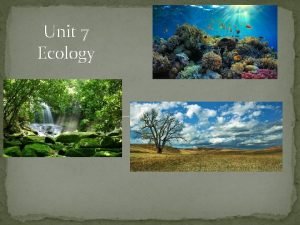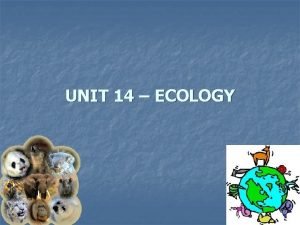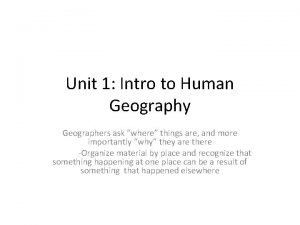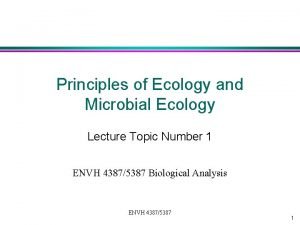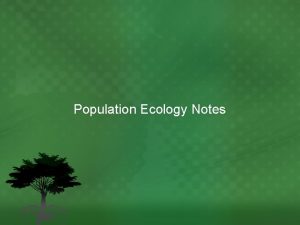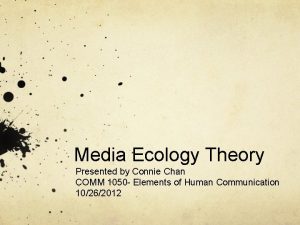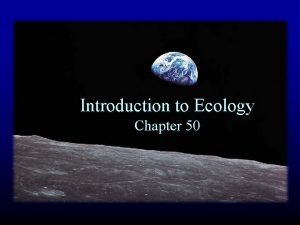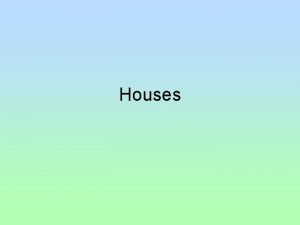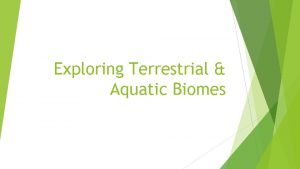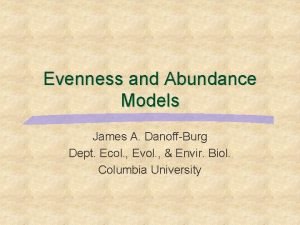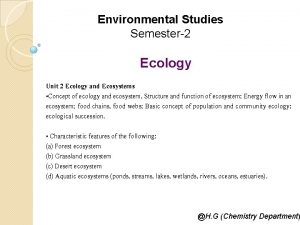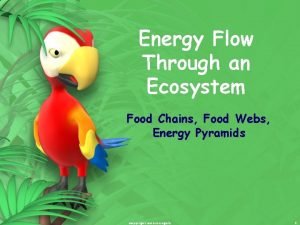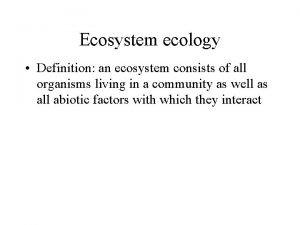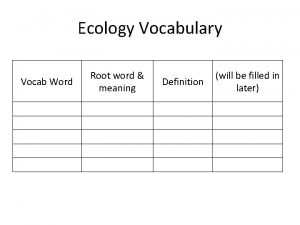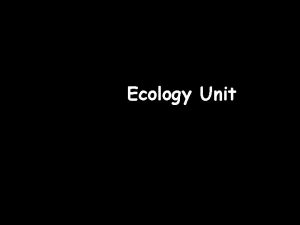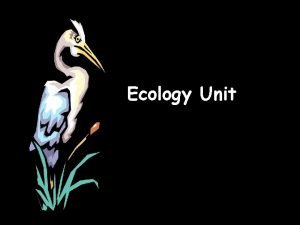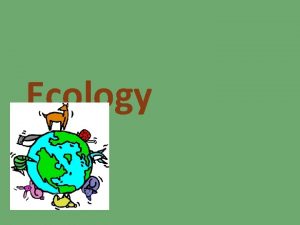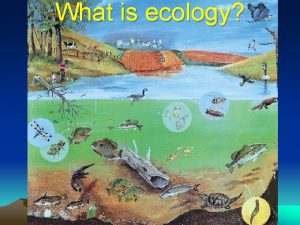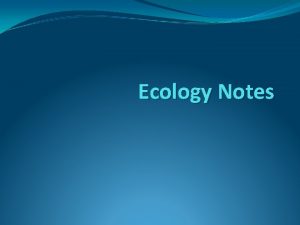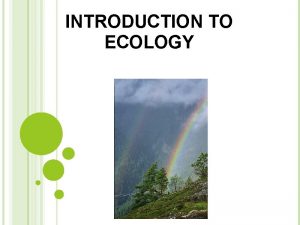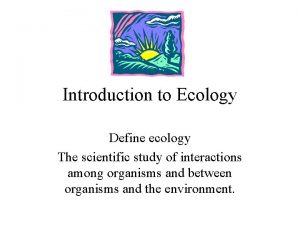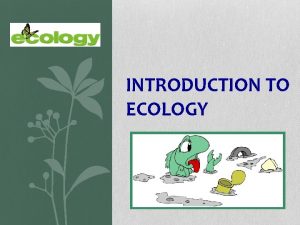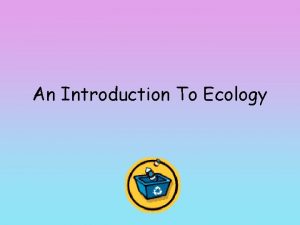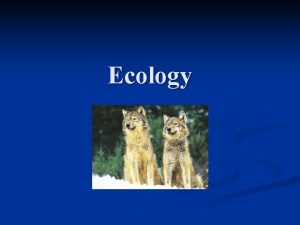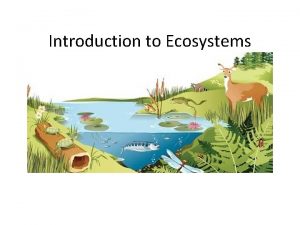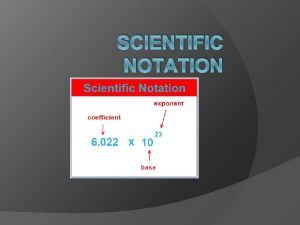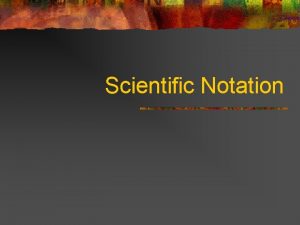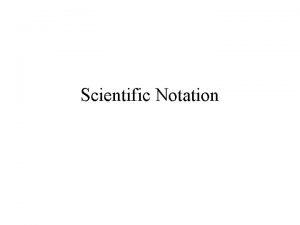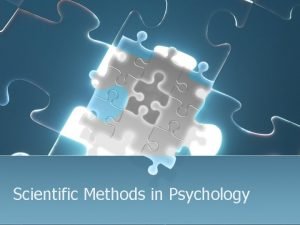ECOLOGY Introduction to Ecology Ecology is the scientific










































































- Slides: 74

ECOLOGY

Introduction to Ecology • Ecology is the scientific study of interactions between organisms and their environments • Every part of the environment is important in ecology. Ecology includes more than just living things. – Living aspects of the environment are referred to as biotic factors – Non-living aspects that have an impact on life (water, weather, temperature, etc) are called abiotic factors.

Introduction to Ecology • Just like the body is organized into levels, so is the environment • Organization of Ecology: – Individual living things are called Organisms (Those of the same species make a…) – Population (Different species groups interacting together make a …) – Community (Living things interacting with abiotic factors makes an …) – Ecosystem (all of the ecosystems around the world make up the …) – Biosphere




What are Biomes? Biomes are ecosystems found around the world that share similar plant structures, plant spacing, animals, etc. The type of biome a region has depends on the local climate (average temperature, seasonality) and amount of rainfall.

Latitude Generally, areas found at the same latitude (North South) will have the same biome. There are three temperature regions found on Earth - Arctic: (poles) COLD pretty much all year or most of the year. - Temperate: Warm summers and Cold Winters, Four seasons. - Tropical: (equator) HOT pretty much all year or most of the year.

Tundra (Artic) • Very cold all the time • Low diversity (few varieties of organisms) because few plants • Simple vegetation (ground is too cold for trees and growing season is very short) • Characterized by Permafrost – soil below a certain point never thaws • Example: Alaska, Antarctica




Grasslands (temperate or tropical) These areas that do not get enough rainfall for trees. They are dominated by grasses as the main plant. There are two types of grasslands. The tropical grasslands (called the savannah) has a wet (rainy) and dry season, but is warm year round. The temperate grasslands have a hot summer and cold winter and four seasons. Grasslands have a lot of grazing animals and are great for farming. Example: African Savannah (Pete’s Pond), Midwestern US (fields of wheat as far as the eye can see, bison, etc. )






Desert (Artic, Temperate, or Tropical) • Deserts can be found ANYWHERE (hot or cold). Only based on the amount of rainfall in the region. VERY little water in these areas. • Very little vegetation • Very few animals • Often experience extreme temperature variations (100+ during the day and 40 at night. ) • Example: Sahara, Arizona, Siberia






Rainforest (Temperate or Tropical) • Very rainy! Lots of trees and animals. Very diverse, especially the Tropical Rainforests contain more species than all of the other biomes combined. • Tropical is warm year round while the temperate has four seasons. • Soil is surprisingly nutrient-poor and acidic b/c of all the rain. • Examples: Amazon, Northern Pacific (Forks, WA)







Coniferous Forest (Temperate/Arctic Border) • Also called the taiga or boreal forest, this is the largest terrestrial biome. There are seasons, but summer is short. • Precipitation is primarily snow, so the plants must be equipped with leaves that can handle ice. Most of the trees are pines (conifers). Soil is nutrient poor and acidic. • Animals include woodpeckers, hawks, moose, bear and lynx. • Example: Canada





Decidious Forest (Temperate) • This is our biome in Virginia! • Good amount of precipitation year round, so lots of plants. Four distinct seasons that are about the same length. Most trees have broad leaves for photosynthesizing during summer. They drop these leaves in the fall and go dormant during winter. • Soil is rich thanks to all those dead leaves.





Marine Biome • • • Consists of oceans, coral reefs, and estuaries The ocean is the largest of all ecosystems. The ocean contains a diverse array of plants and animals at various depth zones. • Coral reefs consist mainly of coral. • Estuaries areas where fresh and salt water environments converge. They are biologically diverse, which means they have many different species



Freshwater Biomes • Includes ponds, and lakes; streams and rivers, and wetlands. • Ponds have stagnant water which means it has no current or flow • Streams and rivers move in one direction. • Wetlands areas of standing water that support aquatic plants.



How the biomes handle change… Primary and Secondary Succession

Primary Succession starts from nothing (bare rock)! 1. 2. 3. 4. First in the environment are the pioneer organisms. These create the initial layer of nutrients (soil) and break up the rocks. Next larger plants come in, but ultimately the amount of nutrients in the soil determines the types of species. The most successful species will be those best adapted with the right “range of tolerance”. Different biomes will follow different succession patterns. Every generation of plants will create more soil due to decomposition Competition between plants finally leads to climax community, where the ecosystem no longer changes much.

Primary Succession in our Ecosystem

Secondary Succession is a reset! • Secondary succession is the development of new inhabitants to replace the previous community of plants and animals that has been disrupted or disturbed by an event (e. g. forest fire, flood, harvesting, epidemic disease, pest attack, etc. ). • Secondary succession occurs much faster because there is no need to turn rock into soil first.

Secondary Succession


Environmental Roles and Relationships • Each living thing lives in the biome that fits Range of Tolerance, which is the abiotic factors (temperatures, amount of water, nutrients) that a species can tolerate (accept) to stay alive. The broader the range of tolerance, the more successful and widespread a species will be. • Within the environment, each species has a specific Niche, which is the role or job an organism has in its environment. For example, this may include the area the animal lives, the food it eats, or the food it provides to others. Every niche matters, and each extinction can create a ripple effect that impacts the other species. – Think about it. What would happen to a fox species if all the rabbits in the area went extinct?

Environmental Roles and Relationships • Sometimes living things evolve to depend on another species for survival. This is called a symbiotic relationship. • Symbiotic relationships: critical relationship between 2 organisms. – Symbiosis = “living together”. There are 3 types • Mutualism: Both species benefit from the relationship (e. g. bees and flowers- bees get food, flowers get pollinated) • Commensalism: One species benefits from the relationship, but the other is neither helped nor harmed (e. g. remoras and sharks- remoras loosely attach to sharks to catch a free ride, but the shark doesn’t know they are there. ) • Parasitism: One species benefits from the relationship, but the other is harmed. Different from a predator because parasites don’t want to kill their host. If they did,

Mutualism – both benefit, neither is harmed

Commensalisms – one benefits, the other doesn’t, but is not harmed

Parasitism – one benefits, the other (host) is harmed and might die

Energy and Nutrient Transfer in Ecosystems • Autotrophs vs. Heterotrophs: – Autotrophs can utilize light energy (photosynthesis) or inorganic chemicals (chemosynthesis) to produce their own chemical energy (sugars). The provide the basis for every other organism in the food chain. – Heterotrophs must consume some other organism to get their chemical energy. • Food Chain: Shows one possibility of energy transfer in an ecosystem. Each feeding step is called a trophic level. • Food Webs: shows many possibilities of energy transfer in an ecosystem (since many organisms eat more then one type of food). Food Webs tend

• Food or Energy Pyramid: Shows amount of energy available at each trophic level. This can be shown as calories, or biomass. – 10% rule: As you go up each trophic level, 90% of the energy is used and only 10% will transfer to the next level. • Biomass: total mass of all individuals and their parts of a species in an ecosystem. There is always more biomass at low trophic levels than at high trophic levels because there is more energy in the lower


Biological Magnification • As you go up a food chain, the amount of energy will decrease as it is being used. However, this is not true for toxins that are often accidentally ingested from the environment. Toxins are not used by the body, and therefore take a long time to be purged. Because of this, they tend to accumulate higher and higher as you go up each trophic level. Therefore, even a small amount of toxin in the environment can result in a

Invasive Species • Pollution, habitat destruction, and interference are all ways that humans can negatively impact an ecosystem. However, sometimes humans impact an area unintentionally through the introduction of an invasive species. • Invasive species are new organisms that are introduced to an environment they are not native to. These newcomers often outcompete the native organisms and cause a disruption in the ecosystem balance.

Invasive Species

Invasive Species

Food chains are important, but life needs more than energy to survive. BIOGEOCHEMICAL CYCLES

Water Cycle Steps: • 1. water evaporates from bodies of water or directly from the leaves of plants (called transpiration) • 2. condenses in atmosphere form clouds • 3. precipitation occurs • 4. rain runs off into bodies of water or is absorbed by plants from runoff (when water runs along the ground) or groundwater (when water sinks into the ground)

Water Cycle

Carbon Cycle • 1 Way to remove Carbon from the atmosphere – 1. CO 2 is absorbed from the atmosphere by plants during photosynthesis. • 4 Ways of returning carbon to atmosphere: – 1. Plants release it during respiration – 2. Animals release it during respiration – 3. Plants and animals die and decompose releasing (stinky) carbon gases to atmosphere – 4. Decomposition underground may result in fossil fuels. Eventually, these can be dug up and burned which returns Carbon to the air

Carbon Cycle • Carbon in the atmosphere is a greenhouse gas, which means it traps heat like a blanket around the earth. Too much carbon traps too much heat. An imbalance in the carbon cycle (e. g. from burning too many fossil fuels) contributes to climate change.

Carbon Cycle

The Nitrogen Cycle: • Steps: • 1. Nitrogen gas is abundant in the atmosphere, but most living things can’t use it as a gas. Special bacteria called nitrogen fixating bacteria must change the gas into nitrogen compounds before plants can use it. • 2. The new nitrogen compounds are absorbed by plants, which are then eaten by animals. • 3. Nitrogen passes through the food chain when consumers eat protein. • 4. When living things die, the nitrogen may be denitrified and returned to the atmosphere by bacteria or immediately reabsorbed by a plant.

Nitrogen Cycle

Population Dynamics • Limiting factors: factor that restricts the existence, numbers, reproduction, or distribution of organisms • Populations are not stagnant (do not stay the same) • Follow exponential growth at the beginning • Continue to grow until Carrying capacity of env. is reached (resources start to run out) • Growth levels out and becomes logistic > Limiting factors kick in > Pop decreases back to the carrying capacity
 Scientific inquiry vs scientific method
Scientific inquiry vs scientific method How is a scientific law different from a scientific theory?
How is a scientific law different from a scientific theory? Hình ảnh bộ gõ cơ thể búng tay
Hình ảnh bộ gõ cơ thể búng tay Bổ thể
Bổ thể Tỉ lệ cơ thể trẻ em
Tỉ lệ cơ thể trẻ em Gấu đi như thế nào
Gấu đi như thế nào Chụp tư thế worms-breton
Chụp tư thế worms-breton Chúa yêu trần thế
Chúa yêu trần thế Các môn thể thao bắt đầu bằng từ đua
Các môn thể thao bắt đầu bằng từ đua Thế nào là hệ số cao nhất
Thế nào là hệ số cao nhất Các châu lục và đại dương trên thế giới
Các châu lục và đại dương trên thế giới Cong thức tính động năng
Cong thức tính động năng Trời xanh đây là của chúng ta thể thơ
Trời xanh đây là của chúng ta thể thơ Cách giải mật thư tọa độ
Cách giải mật thư tọa độ Làm thế nào để 102-1=99
Làm thế nào để 102-1=99 độ dài liên kết
độ dài liên kết Các châu lục và đại dương trên thế giới
Các châu lục và đại dương trên thế giới Thơ thất ngôn tứ tuyệt đường luật
Thơ thất ngôn tứ tuyệt đường luật Quá trình desamine hóa có thể tạo ra
Quá trình desamine hóa có thể tạo ra Một số thể thơ truyền thống
Một số thể thơ truyền thống Cái miệng nó xinh thế chỉ nói điều hay thôi
Cái miệng nó xinh thế chỉ nói điều hay thôi Vẽ hình chiếu vuông góc của vật thể sau
Vẽ hình chiếu vuông góc của vật thể sau Biện pháp chống mỏi cơ
Biện pháp chống mỏi cơ đặc điểm cơ thể của người tối cổ
đặc điểm cơ thể của người tối cổ Ví dụ giọng cùng tên
Ví dụ giọng cùng tên Vẽ hình chiếu đứng bằng cạnh của vật thể
Vẽ hình chiếu đứng bằng cạnh của vật thể Phối cảnh
Phối cảnh Thẻ vin
Thẻ vin đại từ thay thế
đại từ thay thế điện thế nghỉ
điện thế nghỉ Tư thế ngồi viết
Tư thế ngồi viết Diễn thế sinh thái là
Diễn thế sinh thái là Các loại đột biến cấu trúc nhiễm sắc thể
Các loại đột biến cấu trúc nhiễm sắc thể Các số nguyên tố
Các số nguyên tố Tư thế ngồi viết
Tư thế ngồi viết Lời thề hippocrates
Lời thề hippocrates Thiếu nhi thế giới liên hoan
Thiếu nhi thế giới liên hoan ưu thế lai là gì
ưu thế lai là gì Hổ sinh sản vào mùa nào
Hổ sinh sản vào mùa nào Khi nào hổ mẹ dạy hổ con săn mồi
Khi nào hổ mẹ dạy hổ con săn mồi Hệ hô hấp
Hệ hô hấp Từ ngữ thể hiện lòng nhân hậu
Từ ngữ thể hiện lòng nhân hậu Thế nào là mạng điện lắp đặt kiểu nổi
Thế nào là mạng điện lắp đặt kiểu nổi Chapter 52 an introduction to ecology and the biosphere
Chapter 52 an introduction to ecology and the biosphere Chaparral climograph
Chaparral climograph Section 18-1 introduction to ecology worksheet answers
Section 18-1 introduction to ecology worksheet answers Lesson 1: introduction to ecology answer key
Lesson 1: introduction to ecology answer key Introduction to chemistry section 3 scientific methods
Introduction to chemistry section 3 scientific methods Body paragraph
Body paragraph Ecology webquest answers
Ecology webquest answers Communities and biomes virtual lab answers
Communities and biomes virtual lab answers Unit 7 ecology answer key
Unit 7 ecology answer key Ernst haeckel ecology
Ernst haeckel ecology Difference between formal and functional region
Difference between formal and functional region Sustainability definition ap human geography
Sustainability definition ap human geography Difference between ecology and environment
Difference between ecology and environment Whats climax community
Whats climax community Ecology deals with
Ecology deals with Ecological niche
Ecological niche Logistic growth ecology definition
Logistic growth ecology definition Biotic potential definition
Biotic potential definition Logistic and exponential growth
Logistic and exponential growth Mind map about media and information literacy
Mind map about media and information literacy What is media ecology
What is media ecology Tropical grassland
Tropical grassland Folk housing
Folk housing Population vs community ecology
Population vs community ecology What biome has bison
What biome has bison Broken stick model ecology
Broken stick model ecology Difference between ecosystem and ecology
Difference between ecosystem and ecology Primary consumer ecology
Primary consumer ecology An ecosystem consists of
An ecosystem consists of In the word decomposition what is the root word brainpop
In the word decomposition what is the root word brainpop Food web keystone species
Food web keystone species












































